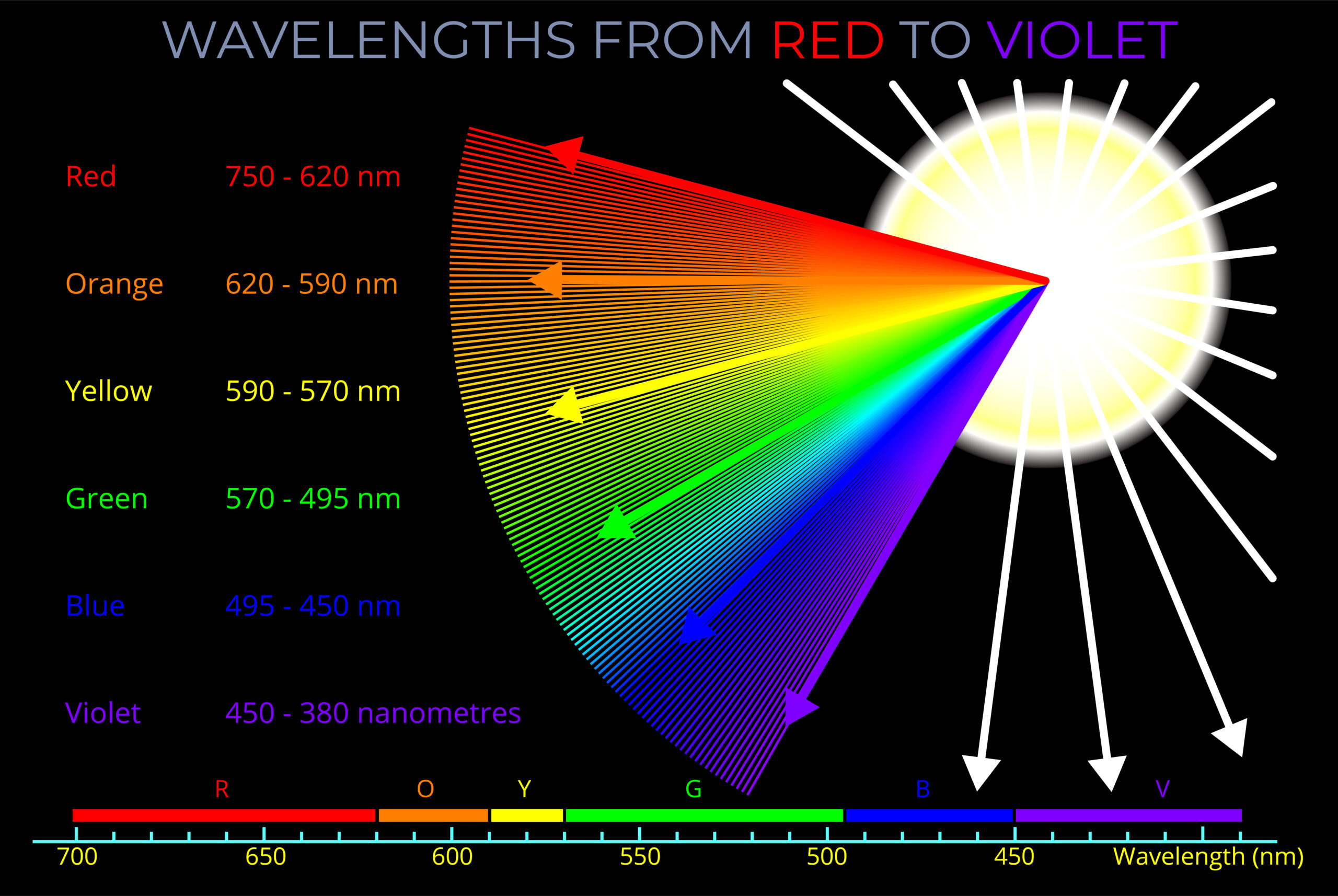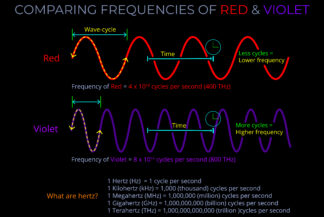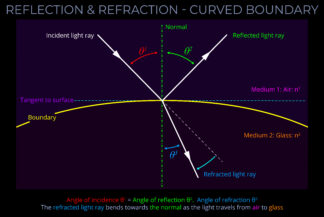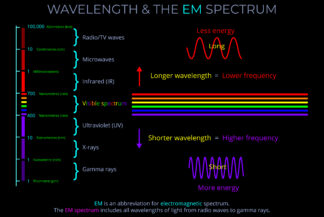Wavelengths from Red to Violet
£0.00
This diagram is about which wavelengths of electromagnetic radiation correspond with the different colours we see in the world.
The important fact to remember is that the wavelengths of light within the visible spectrum correspond with all the colours that we see between red and violet.
- The white arrows in the diagram show the Sun emitting sunlight at all wavelengths of the visible spectrum.
- The term white light is used when all colours of the visible spectrum are mixed together.
- The spectrum of colours between red and violet illustrates that although an observer will often describe visible light (a rainbow for example) as six bands of colour, each and every wavelength between 700 and 430 nanometres is a different colour.
- The list on the left shows the range of wavelengths corresponding with each band of colour.
- The red arrow, for example, corresponds with wavelengths between 700 nanometres and 620 nanometres. Red is the colour an observer sees if any wavelength in that range strikes a neutral coloured surface.
- The scale along the bottom is marked in nanometres and shows the visible spectrum divided into coloured bands.
Description
Wavelengths from Red to Violet
TRY SOME QUICK QUESTIONS AND ANSWERS TO GET STARTED
About the diagram
About the diagram
- This diagram is about which wavelengths of electromagnetic radiation correspond with the different colours we see in the world.
- The important fact to remember is that the wavelengths of light within the visible spectrum correspond with the spectral colours we see between red and violet.
- The white arrows in the diagram show the Sun emitting sunlight at all wavelengths of the visible spectrum.
- The term white light is used when all wavelengths and the colours of the visible spectrum are mixed together.
- The full spectrum of colours between red and violet illustrates that each and every wavelength between 700 and 430 nanometres produces a different colour.
- The list on the left shows the ranges of wavelengths that correspond with the most prominent spectral colours
- The scale along the bottom is marked in nanometres and shows the visible spectrum divided into coloured bands.
Remember that:
- Objects appear to be different colours to an observer depending on their wavelength.
- The name given to light that contains all wavelengths of the visible spectrum is white light.
- When all wavelengths contained in white light reflect off a neutral-coloured surface then the object appears white to an observer.
- When a narrow band of wavelengths reflect off a neutral-coloured surface then the object appears coloured to an observer.
- The colour an observer sees depends on:
- The wavelengths of visible light emitted by a light source.
- The wavelengths absorbed or reflected off an object.
- Although a human observer can distinguish between many thousands of wavelengths of light in the visible spectrum, the impression is often of predominant bands of colour.
Some key terms
The visible spectrum is the range of wavelengths of the electromagnetic spectrum that correspond with all the different colours we see in the world.
- As light travels through the air it is invisible to our eyes.
- Human beings don’t see wavelengths of light, but they do see the spectral colours that correspond with each wavelength and colours produced when different wavelengths are combined.
- The visible spectrum includes all the spectral colours between red and violet and each is produced by a single wavelength.
- The visible spectrum is often divided into named colours, though any division of this kind is somewhat arbitrary.
- Traditional colours referred to in English include red, orange, yellow, green, blue, and violet.
Electromagnetic radiation is a type of energy more commonly simply called light. Detached from its source, it is transported by electromagnetic waves (or their quanta, photons) and propagates through space at the speed of light.
- Electromagnetic radiation (EM radiation or EMR) includes radio waves, microwaves, infrared, (visible) light, ultraviolet, X-rays, and gamma rays.
- Man-made technologies that produce electromagnetic radiation include radio and TV transmitters, radar, MRI scanners, microwave ovens, computer screens, mobile phones, all types of lights and lamps, electric blankets, electric bar heaters, lasers and x-ray machines.
- At the quantum scale of electromagnetism, electromagnetic radiation is described in terms of photons rather than waves. Photons are elementary particles responsible for all electromagnetic phenomena.
- The term quantum refers to the smallest quantity into which something can be divided. A quantum of a thing is indivisible into smaller units so they have no sub-structure. A photon is a quantum of electromagnetic radiation.
- A single photon with a wavelength corresponding with gamma rays might carry 100,000 times the energy of a single photon of visible light.
Sunlight, also known as daylight or visible light, refers to the portion of electromagnetic radiation emitted by the Sun that is detectable by the human eye. It is one form of the broad range of electromagnetic radiation produced by the Sun. Our eyes are particularly sensitive to this specific range of wavelengths, enabling us to perceive the Sun and the world around us.
- Sunlight is only one form of electromagnetic radiation emitted by the Sun.
- Sunlight is only a very small part of the electromagnetic spectrum.
- Sunlight is the form of electromagnetic radiation that our eyes are sensitive to.
- Other types of electromagnetic radiation that we are sensitive to, but cannot see, are infrared radiation that we feel as heat and ultraviolet radiation that causes sunburn.
Visible light is the range of wavelengths of electromagnetic radiation perceived as colour by human observers.
- Visible light is a form of electromagnetic radiation.
- Other forms of electromagnetic radiation include radio waves, microwaves, infrared, ultraviolet, X-rays, and gamma rays.
- Visible light is perceived by a human observer as all the spectral colours between red and violet plus all other colours that result from combining wavelengths together in different proportions.
- A spectral colour is produced by a single wavelength of light.
- The complete range of colours that can be perceived by a human observer is called the visible spectrum.
- The range of wavelengths that produce visible light is a very small part of the electromagnetic spectrum.
White light is the term for visible light that contains all wavelengths of the visible spectrum at equal intensities.
- The sun emits white light because sunlight contains all the wavelengths of the visible spectrum in roughly equal proportions.
- Light travelling through a vacuum or a medium is termed white light if it includes all wavelengths of visible light.
- Light travelling through a vacuum or air is not visible to our eyes unless it interacts with something.
- The term white light can have two meanings:
- It can refer to a combination of all wavelengths of visible light travelling through space, regardless of observation.
- What a person sees when all colours of the visible spectrum hit a white or neutral-coloured surface.
Wavelength measures a complete wave cycle, which is the distance from any point on a wave to the corresponding point on the next wave.
- While wavelength can be measured from any point on a wave, it is often simplest to measure from the peak of one wave to the peak of the next or from the bottom of one trough to the bottom of the next, ensuring the measurement covers the whole of the cycle.
- The wavelength of an electromagnetic wave is usually given in metres.
- The wavelength of visible light is typically measured in nanometres, with 1,000,000,000 nanometres making up a metre.
- Radio waves, visible light, and gamma waves for example, each have different ranges of wavelengths within the electromagnetic spectrum.
Visible light refers to the range of wavelengths of electromagnetic radiation that is perceived as colour by human observers. While the range of visible light is generally considered to be 400-700 nm, the exact range of colours perceptible can vary slightly between individuals.
- Visible light is one form of electromagnetic radiation. Other forms of electromagnetic radiation include radio waves, microwaves, infrared, ultraviolet, X-rays, and gamma rays. Visible light ranges from approximately 400 nanometres (nm) for violet to 700 nm for red.
- A human observer perceives visible light as a combination of all the spectral colours between red and violet, as well as a vast range of other colours produced from the blending of different wavelengths in varying proportions.
The visible part of the electromagnetic spectrum is called the visible spectrum.
- The visible spectrum is the range of wavelengths of the electromagnetic spectrum that correspond with all the different colours we see in the world.
- As light travels through the air it is invisible to our eyes.
- Human beings don’t see wavelengths of light, but they do see the spectral colours that correspond with each wavelength and colours produced when different wavelengths are combined.
- The visible spectrum includes all the spectral colours between red and violet and each is produced by a single wavelength.
- The visible spectrum is often divided into named colours, though any division of this kind is somewhat arbitrary.
- Traditional colours referred to in English include red, orange, yellow, green, blue, and violet.



